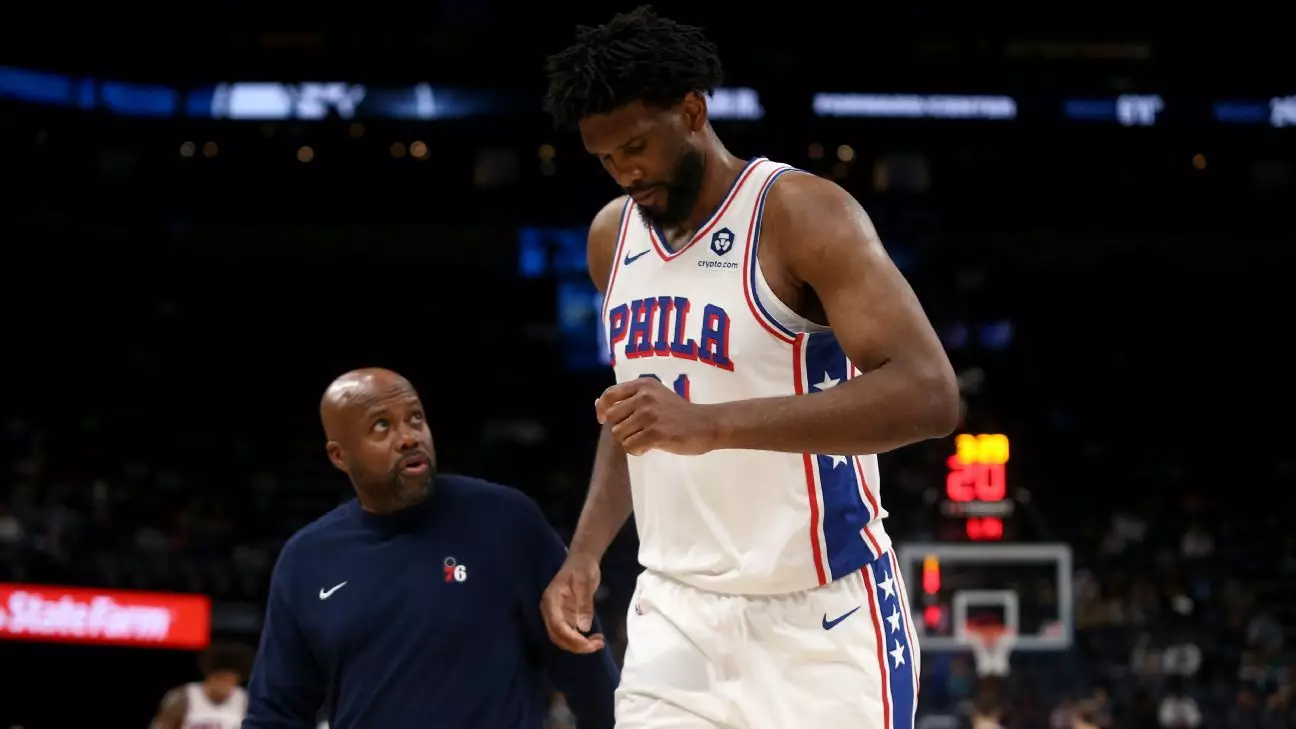In the fast-paced and high-pressure world of professional basketball, injuries can significantly divert the trajectory of even the most promising teams. The Philadelphia 76ers and their star center, Joel Embiid, are currently at a crucial juncture marked by uncertainty regarding his injured left knee. Reports indicate that both Embiid and the 76ers are actively consulting medical professionals and exploring a range of treatment options, including the possibility of surgery, to address this ongoing issue. The situation is particularly concerning given that it has hampered Embiid’s ability to contribute consistently, thus impacting the 76ers’ overall performance this season.
For fans and the organization alike, the hope was that Embiid’s condition would improve in time for him to play a pivotal role in the playoffs. However, despite numerous interventions, including regular injections aimed at managing his pain, the situation has not bucked the trend of stagnation. This week set the stage for further evaluations as both parties assess the next steps—an indication that serious contemplation around surgical options is on the table. With Embiid himself admitting to the potential need for surgery or an extended rest, the looming question becomes: What does this mean for both his career and the 76ers’ aspirations this season?
Embiid’s recent performance has compounded the concerns surrounding his health. Over the last few games, he’s displayed alarming signs of decline, including a particularly troubling outing against the Brooklyn Nets where he managed to score only 14 points, a far cry from his expected contribution. Such performances are symptomatic of the physical struggles he is enduring; it’s not merely a question of numbers, but of his overall presence on the court. Scoring 15 points or fewer in consecutive games—something he hadn’t experienced since May 2021—highlights a downward spiral that players of his caliber seldom encounter.
The statistics speak volumes; he has only managed to participate in 19 of 56 games this season due to the lingering knee troubles coupled with a foot sprain. The last time Embiid faced such extensive time out was when he tore the meniscus in his knee last season, leading to knee surgery in February. While he returned for the playoff run, the serious dedication and effort he invested over the summer to earn a gold medal with the U.S. Olympic team left an indelible mark on his recovery timeline. Yet, as he conceded earlier this month, the time available for a full recovery was painfully inadequate.
The impact of Embiid’s injury, alongside the challenges faced by other crew members, has undoubtedly cast a shadow over the 76ers’ season. Once perceived as championship contenders, they now find themselves deeply entrenched in disappointment, having lost seven consecutive games, leading to a bleak record of 20-36. Ironically, a silver lining might be discerned in their slip to the sixth-worst record in the league; however, for a franchise that initially ignited hopes of glory, this is merely a perverse consolation.
Alongside Embiid, players like Paul George are wrestling with their injuries. Reports of George dealing with a left pinkie tendon injury and a groin strain illustrate that the 76ers are grappling not just with a star player’s injury but a broader injury crisis that undermines their collective efforts. Even when key players are on the court, the 76ers’ record reveals a muted performance—hovering around .500 with a 7-8 record when their stars play. This inconsistency is a harbinger of deeper issues that raise doubts within the fanbase about the team’s strategy and resilience moving forward.
As the 76ers confront these turbulent waters, the forthcoming medical evaluations for Embiid will play a decisive role in shaping the franchise’s strategy for the future. Should a surgical option be chosen, the team must grapple with the implications of a prolonged absence of one of its stars. Conversely, embracing a conservative rest strategy may lead to temporary relief, but it is a gamble that could jeopardize the season and Embiid’s longevity as a key player.
Moving ahead, the 76ers will require a combination of prudent decision-making, reliance on their remaining talent, and perhaps even reinforcements via trades or acquisitions to weather this adversity effectively. For now, the priority remains focused on understanding Embiid’s health and strategizing accordingly to foster a more optimistic outlook as the season progresses, ensuring that the franchise does not merely drift into mediocrity but actively seeks restoration and success.

